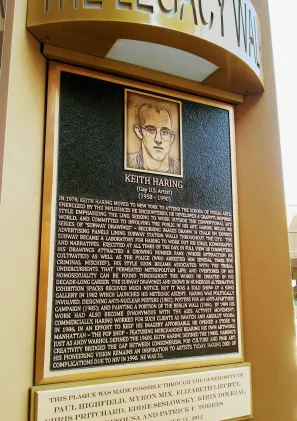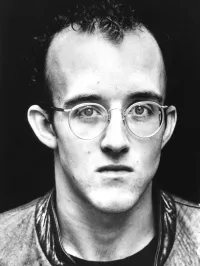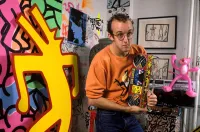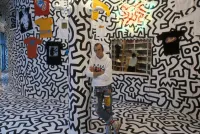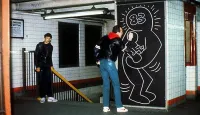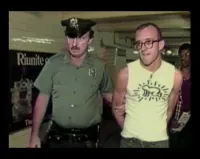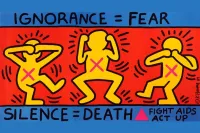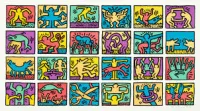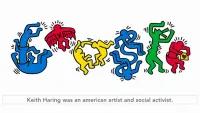Plaque Sponsor
Paul Highfield, Myron Mix, Elizabeth Liechty, Chris Pritchard, Eddie Seslowsky, Kirin Dolezal, Paul Desousa and Patrick F. TorresBiography
1958 - 1990
"I don't think art is propaganda; it should be something that liberates the soul, provokes the imagination and encourages people to go further. It celebrates humanity instead of manipulating it."
- Keith Haring
In 1978, Keith Haring moved to New York to attend the School of Visual Arts. Energized by the influences he encountered, he developed a graffiti-inspired style emphasizing the line. Seeking to work outside the conventional art world, and committed to involving the public in his art, Haring began his series of “subway drawings” – recurring images drawn in chalk on expired advertising panels lining subway station walls throughout the city. The subway became a laboratory for Haring to work out his ideas, iconography and narratives. Executed at all times of the day, in full view of commuters, his drawings attracted a growing number fans (whose interaction he cultivated) as well as the police (who arrested him several times for criminal mischief). His style soon became associated with the tribal undercurrents that permeated metropolitan life; and overtones of his homosexuality can be found throughout the works he created in his decade-long career. The subway drawings and his shows in numerous alternative exhibition spaces received much notice, but it was a solo show at a Soho gallery in 1982 which launched his meteoric ascent. Haring was politically involved, designing anti-nuclear posters (1982); posters for an anti-apartheid campaign (1985); and painting a portion of the Berlin Wall (1986). By 1989 his work had also become synonymous with the AIDS activist movement. Commercially, Haring worked for such clients as Swatch and Absolut Vodka. In 1986, in an effort to keep his imagery affordable, he opened a store in Manhattan – the Pop Shop – featuring merchandise bearing his own artwork. Just as Andy Warhol defined the 1960s, Keith Haring defined the 1980s. Haring’s creativity bridged the gap between consumerism, pop culture and fine art. His innovative vision remains an inspiration to artists today. Haring died of complications due to HIV in 1990. He was 31.
1958 - 1990
"I don't think art is propaganda; it should be something that liberates the soul, provokes the imagination and encourages people to go further. It celebrates humanity instead of manipulating it."
- Keith Haring
In 1978, Keith Haring moved to New York to attend the School of Visual Arts. Energized by the influences he encountered, he developed a graffiti-inspired style emphasizing the line. Seeking to work outside the conventional art world, and committed to involving the public in his art, Haring began his series of “subway drawings” – recurring images drawn in chalk on expired advertising panels lining subway station walls throughout the city. The subway became a laboratory for Haring to work out his ideas, iconography and narratives. Executed at all times of the day, in full view of commuters, his drawings attracted a growing number fans (whose interaction he cultivated) as well as the police (who arrested him several times for criminal mischief). His style soon became associated with the tribal undercurrents that permeated metropolitan life; and overtones of his homosexuality can be found throughout the works he created in his decade-long career. The subway drawings and his shows in numerous alternative exhibition spaces received much notice, but it was a solo show at a Soho gallery in 1982 which launched his meteoric ascent. Haring was politically involved, designing anti-nuclear posters (1982); posters for an anti-apartheid campaign (1985); and painting a portion of the Berlin Wall (1986). By 1989 his work had also become synonymous with the AIDS activist movement. Commercially, Haring worked for such clients as Swatch and Absolut Vodka. In 1986, in an effort to keep his imagery affordable, he opened a store in Manhattan – the Pop Shop – featuring merchandise bearing his own artwork. Just as Andy Warhol defined the 1960s, Keith Haring defined the 1980s. Haring’s creativity bridged the gap between consumerism, pop culture and fine art. His innovative vision remains an inspiration to artists today. Haring died of complications due to HIV in 1990. He was 31.
Lesson Plan
Please login or register for an account to view this lesson plan.
Demography
Demography
Gender Male
Sexual Orientation Gay
Gender Identity Cisgender
Ethnicity Caucasian/White
Nations Affiliated United States
Era/Epoch AIDS Era (1980-present) Information Age (1970-present) Post-Stonewall Era (1974-1980)
Field(s) of Contribution
Advocacy & Activism
Art
Art, Music, Literature & Theater
Business
Social Justice
Social Sciences
US History
Commemorations & Honors
Keith Haring Foundation Established by Him (1989)
Nakamura Keith Haring Collection in Hokuto Japan Established (2007)
Macy's Thanksgiving Day Parade Balloon Tribute (2008)
Google Doodle Commemorating Haring's 54th Birthday (2012)
Inaugural San Francisco Rainbow Honor Walk Honoree (2014)
National LGBTQ Wall of Honor at the Stonewall National Monument Inductee (2019)
Demography
Gender Male
Sexual Orientation Gay
Gender Identity Cisgender
Ethnicity Caucasian/White
Nations Affiliated United States
Era/Epoch AIDS Era (1980-present) Information Age (1970-present) Post-Stonewall Era (1974-1980)
Field(s) of Contribution
Advocacy & Activism
Art
Art, Music, Literature & Theater
Business
Social Justice
Social Sciences
US History
Commemorations & Honors
Keith Haring Foundation Established by Him (1989)
Nakamura Keith Haring Collection in Hokuto Japan Established (2007)
Macy's Thanksgiving Day Parade Balloon Tribute (2008)
Google Doodle Commemorating Haring's 54th Birthday (2012)
Inaugural San Francisco Rainbow Honor Walk Honoree (2014)
National LGBTQ Wall of Honor at the Stonewall National Monument Inductee (2019)
Resources
Resources
Celant, Germand, ed. Keith Haring. Munich: Prestel, 1992.
Gruen, John. Keith Haring: The Authorized Biography. New York: Prentice Hall, 1991.
Haring, Keith. Keith Haring, 1988: A One-Man Exhibition in Los Angeles of Paintings, Drawings, and Prints. Los Angeles: M. Kohn Gallery, 1988.
Kurtz, Bruce D., ed. Keith Haring, Andy Warhol, and Walt Disney. Munich: Prestel, 1992.
Sussman, Elisabeth. Keith Haring. New York: Bulfinch Press, 1997.
http://www.rollingstone.com/culture/features/keith-haring-just-say-know-19890810
https://www.mentalfloss.com/article/78388/10-pop-art-facts-about-keith-haring
https://www.pbs.org/wnet/americanmasters/keith-haring-documentary/16918/
Resources
Celant, Germand, ed. Keith Haring. Munich: Prestel, 1992.
Gruen, John. Keith Haring: The Authorized Biography. New York: Prentice Hall, 1991.
Haring, Keith. Keith Haring, 1988: A One-Man Exhibition in Los Angeles of Paintings, Drawings, and Prints. Los Angeles: M. Kohn Gallery, 1988.
Kurtz, Bruce D., ed. Keith Haring, Andy Warhol, and Walt Disney. Munich: Prestel, 1992.
Sussman, Elisabeth. Keith Haring. New York: Bulfinch Press, 1997.
http://www.rollingstone.com/culture/features/keith-haring-just-say-know-19890810
https://www.mentalfloss.com/article/78388/10-pop-art-facts-about-keith-haring
https://www.pbs.org/wnet/americanmasters/keith-haring-documentary/16918/
